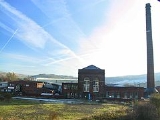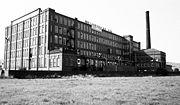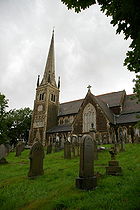
Newhey
Encyclopedia
Newhey is a suburb
an village in the Milnrow
area of the Metropolitan Borough of Rochdale
, in Greater Manchester
, England. It lies at the foot of the Pennines
, by Junction 21 of the M62 motorway
and on the River Beal
, 2.7 miles (4.3 km) east-southeast of Rochdale
, 10.3 miles (16.6 km) northeast of Manchester
.
Historically
a part of Lancashire
, Newhey was anciently a hamlet
within the township of Butterworth
. It was described in 1828 as "consisting of several ranges of cottages and two public houses". In the early 19th century a major road was built through Newhey from Werneth
to Littleborough. Newhey was incorporated into the Milnrow Urban District
in 1894.
Newhey expanded as part of an unplanned process of urbanisation, brought on by the introduction of textile manufacture during the Industrial Revolution
, and is now home to the Ellenroad Steam Museum
- the engine house of the former Ellenroad Ring Mill, the rest of which was demolished in 1985. It holds the world's largest working steam engine.
 Lying by the older localities of Milnrow, Ogden and Haugh, Newhey is thought to have acquired its name as a result of land reclamation
Lying by the older localities of Milnrow, Ogden and Haugh, Newhey is thought to have acquired its name as a result of land reclamation
.
Newhey was home to the Newhey Brick and Terracotta Co. Ltd., a prosperous brick and tile works which opened on Huddersfield Road in 1899. Its bricks are found in buildings worldwide. Most mills and associated terraced houses in the Rochdale and Oldham
areas were built from this "Newhey brick".
In the 1920s, Newhey had at least five cotton mill
s, including Ellenroad
, Newhey, Coral, Haugh and Garfield (demolished 1969).
of Rochdale parish
, in the Hundred of Salfordshire
.
From 1894 to 1974, Newhey was part of Milnrow Urban District
in the administrative county
of Lancashire. In the local government reforms
of 1974, this Urban District
status was abolished and Newhey is now part of the Metropolitan Borough of Rochdale
.
Newhey was previously part of the Littleborough and Saddleworth
constituency. It is now represented in the House of Commons
as part of the parliamentary constituency of Rochdale
.
 Localities in and around Newhey include Haugh and Woodbottom. Several reservoirs lie above and to the east, including Ogden, Kitcliffe
Localities in and around Newhey include Haugh and Woodbottom. Several reservoirs lie above and to the east, including Ogden, Kitcliffe
and Piethorne
.
 Milnrow War Memorial
Milnrow War Memorial
, a Grade II listed structure, is in Newhey's Memorial Park. Originally in central Milnrow (set back from the road near Milnrow Bridge), it was unveiled in 1924 by Major General A Solly-Flood, a former commander of 42nd (East Lancashire) Division
. Sculpted from Sandstone
by G Thomas in 1923, the memorial is surmounted by a bronze statue of a World War I
Infantry
soldier with rifle and fixed bayonet
, symbolic of the district's young manhood in early World War I. The plinth has bronze and slate panels which show the names of local men who died in the two World Wars.
Ellenroad Engine House was designed by Sir Philip Stott, 1st Baronet
. Its tall chimney makes it a local landmark.
Newhey parish church, dedicated to Saint Thomas
, was built in 1876 to serve the new Anglican
parish of Newhey. Its patron is the Bishop of Manchester
. The church was badly damaged by arson on 21 December 2007.
Suburb
The word suburb mostly refers to a residential area, either existing as part of a city or as a separate residential community within commuting distance of a city . Some suburbs have a degree of administrative autonomy, and most have lower population density than inner city neighborhoods...
an village in the Milnrow
Milnrow
Milnrow is a suburban town within the Metropolitan Borough of Rochdale, in Greater Manchester, England. It lies on the River Beal at the foothills of the South Pennines, and forms a continuous urban area with Rochdale...
area of the Metropolitan Borough of Rochdale
Metropolitan Borough of Rochdale
The Metropolitan Borough of Rochdale is a metropolitan borough of Greater Manchester in North West England. It is named after its largest town, Rochdale, but spans a far larger area which includes the towns of Middleton, Heywood, Littleborough and Milnrow, and the village of Wardle.The borough was...
, in Greater Manchester
Greater Manchester
Greater Manchester is a metropolitan county in North West England, with a population of 2.6 million. It encompasses one of the largest metropolitan areas in the United Kingdom and comprises ten metropolitan boroughs: Bolton, Bury, Oldham, Rochdale, Stockport, Tameside, Trafford, Wigan, and the...
, England. It lies at the foot of the Pennines
Pennines
The Pennines are a low-rising mountain range, separating the North West of England from Yorkshire and the North East.Often described as the "backbone of England", they form a more-or-less continuous range stretching from the Peak District in Derbyshire, around the northern and eastern edges of...
, by Junction 21 of the M62 motorway
M62 motorway
The M62 motorway is a west–east trans-Pennine motorway in Northern England, connecting the cities of Liverpool and Hull via Manchester and Leeds. The road also forms part of the unsigned Euroroutes E20 and E22...
and on the River Beal
River Beal
The Beal is a small river in Greater Manchester, England, and is a tributary of the River Roch. It rises in the Beal Valley in green space between Sholver and Royton, before continuing northwards through, Shaw and Crompton, Newhey, Milnrow and Belfield....
, 2.7 miles (4.3 km) east-southeast of Rochdale
Rochdale
Rochdale is a large market town in Greater Manchester, England. It lies amongst the foothills of the Pennines on the River Roch, north-northwest of Oldham, and north-northeast of the city of Manchester. Rochdale is surrounded by several smaller settlements which together form the Metropolitan...
, 10.3 miles (16.6 km) northeast of Manchester
Manchester
Manchester is a city and metropolitan borough in Greater Manchester, England. According to the Office for National Statistics, the 2010 mid-year population estimate for Manchester was 498,800. Manchester lies within one of the UK's largest metropolitan areas, the metropolitan county of Greater...
.
Historically
Historic counties of England
The historic counties of England are subdivisions of England established for administration by the Normans and in most cases based on earlier Anglo-Saxon kingdoms and shires...
a part of Lancashire
Lancashire
Lancashire is a non-metropolitan county of historic origin in the North West of England. It takes its name from the city of Lancaster, and is sometimes known as the County of Lancaster. Although Lancaster is still considered to be the county town, Lancashire County Council is based in Preston...
, Newhey was anciently a hamlet
Hamlet (place)
A hamlet is usually a rural settlement which is too small to be considered a village, though sometimes the word is used for a different sort of community. Historically, when a hamlet became large enough to justify building a church, it was then classified as a village...
within the township of Butterworth
Butterworth (ancient township)
Butterworth was a township occupying the southeastern part of the parish of Rochdale, in the hundred of Salford, Lancashire, England. It encompassed of land by the South Pennines which spanned the settlements of Belfield, Bleaked-gate-cum-Roughbank, Butterworth Hall, Clegg, Firgrove, Haughs,...
. It was described in 1828 as "consisting of several ranges of cottages and two public houses". In the early 19th century a major road was built through Newhey from Werneth
Werneth, Greater Manchester
Werneth is an area of Oldham, in Greater Manchester, England. It is west-southwest of Oldham's commercial centre and one of Oldham's most ancient localities.-History:...
to Littleborough. Newhey was incorporated into the Milnrow Urban District
Milnrow Urban District
Milnrow Urban District was, from 1894 to 1974, a local government district of the administrative county of Lancashire, in northwest England. It covered an area to the east and southeast of the County Borough of Rochdale, and included the town of Milnrow, the village of New Hey, and the Piethorne...
in 1894.
Newhey expanded as part of an unplanned process of urbanisation, brought on by the introduction of textile manufacture during the Industrial Revolution
Textile manufacture during the Industrial Revolution
The industrial revolution changed the nature of work and society. Opinion varies as to the exact date, but it is estimated that the First Industrial Revolution took place between 1750 and 1850, and the second phase or Second Industrial Revolution between 1860 and 1900. The three key drivers in...
, and is now home to the Ellenroad Steam Museum
Ellenroad Ring Mill Engine
The Ellenroad Ring Mill Engine is a preserved stationary steam engine in Milnrow, Greater Manchester. It powered the Ellenroad Ring Mill from 1917, and after the mill's closure the engine is still worked under steam as a museum display....
- the engine house of the former Ellenroad Ring Mill, the rest of which was demolished in 1985. It holds the world's largest working steam engine.
History

Land reclamation
Land reclamation, usually known as reclamation, is the process to create new land from sea or riverbeds. The land reclaimed is known as reclamation ground or landfill.- Habitation :...
.
Newhey was home to the Newhey Brick and Terracotta Co. Ltd., a prosperous brick and tile works which opened on Huddersfield Road in 1899. Its bricks are found in buildings worldwide. Most mills and associated terraced houses in the Rochdale and Oldham
Oldham
Oldham is a large town in Greater Manchester, England. It lies amid the Pennines on elevated ground between the rivers Irk and Medlock, south-southeast of Rochdale, and northeast of the city of Manchester...
areas were built from this "Newhey brick".
In the 1920s, Newhey had at least five cotton mill
Cotton mill
A cotton mill is a factory that houses spinning and weaving machinery. Typically built between 1775 and 1930, mills spun cotton which was an important product during the Industrial Revolution....
s, including Ellenroad
Ellenroad Mill
Ellenroad Mill was a cotton spinning mill in Newhey, Milnrow, Rochdale in England. It was built as a mule spinning mill in 1890 by Stott and Sons and extended in 1899. It was destroyed by fire on 19 Jan 1916...
, Newhey, Coral, Haugh and Garfield (demolished 1969).
Governance
From a very early time, Newhey was part of the Butterworth townshipButterworth (ancient township)
Butterworth was a township occupying the southeastern part of the parish of Rochdale, in the hundred of Salford, Lancashire, England. It encompassed of land by the South Pennines which spanned the settlements of Belfield, Bleaked-gate-cum-Roughbank, Butterworth Hall, Clegg, Firgrove, Haughs,...
of Rochdale parish
Rochdale (ancient parish)
Rochdale was an ecclesiastical parish of early-medieval origin in northern England, administered from the Church of St Chad, Rochdale. At its zenith, it occupied of land amongst the South Pennines, and straddled the historic county boundary between Lancashire and the West Riding of Yorkshire...
, in the Hundred of Salfordshire
Salford (hundred)
The hundred of Salford was an ancient division of the historic county of Lancashire, in Northern England. It was sometimes known as Salfordshire, the name alluding to its judicial centre being the township of Salford...
.
From 1894 to 1974, Newhey was part of Milnrow Urban District
Milnrow Urban District
Milnrow Urban District was, from 1894 to 1974, a local government district of the administrative county of Lancashire, in northwest England. It covered an area to the east and southeast of the County Borough of Rochdale, and included the town of Milnrow, the village of New Hey, and the Piethorne...
in the administrative county
Administrative counties of England
Administrative counties were a level of subnational division of England used for the purposes of local government from 1889 to 1974. They were created by the Local Government Act 1888 as the areas for which county councils were elected. Some large counties were divided into several administrative...
of Lancashire. In the local government reforms
Local Government Act 1972
The Local Government Act 1972 is an Act of Parliament in the United Kingdom that reformed local government in England and Wales on 1 April 1974....
of 1974, this Urban District
Urban district
In the England, Wales and Ireland, an urban district was a type of local government district that covered an urbanised area. Urban districts had an elected Urban District Council , which shared local government responsibilities with a county council....
status was abolished and Newhey is now part of the Metropolitan Borough of Rochdale
Metropolitan Borough of Rochdale
The Metropolitan Borough of Rochdale is a metropolitan borough of Greater Manchester in North West England. It is named after its largest town, Rochdale, but spans a far larger area which includes the towns of Middleton, Heywood, Littleborough and Milnrow, and the village of Wardle.The borough was...
.
Newhey was previously part of the Littleborough and Saddleworth
Littleborough and Saddleworth (UK Parliament constituency)
Littleborough and Saddleworth was a parliamentary constituency in Greater Manchester, England. It returned one Member of Parliament to the House of Commons of the Parliament of the United Kingdom....
constituency. It is now represented in the House of Commons
British House of Commons
The House of Commons is the lower house of the Parliament of the United Kingdom, which also comprises the Sovereign and the House of Lords . Both Commons and Lords meet in the Palace of Westminster. The Commons is a democratically elected body, consisting of 650 members , who are known as Members...
as part of the parliamentary constituency of Rochdale
Rochdale (UK Parliament constituency)
Rochdale is a county constituency represented in the House of Commons of the Parliament of the United Kingdom. It elects one Member of Parliament by the first past the post system of election.-Boundaries:...
.
Geography

Kitcliffe Reservoir
Kitcliffe Reservoir is a reservoir in Piethorne Valley in between Ogden and Piethorne Reservoirs in the Metropolitan Borough of Rochdale, within Greater Manchester, England....
and Piethorne
Piethorne Reservoir
Piethorne Reservoir is the largest of several reservoirs in the Piethorne Valley above Milnrow, in the Metropolitan Borough of Rochdale, Greater Manchester, England. It was built in 1866....
.
Landmarks

War memorial
A war memorial is a building, monument, statue or other edifice to celebrate a war or victory, or to commemorate those who died or were injured in war.-Historic usage:...
, a Grade II listed structure, is in Newhey's Memorial Park. Originally in central Milnrow (set back from the road near Milnrow Bridge), it was unveiled in 1924 by Major General A Solly-Flood, a former commander of 42nd (East Lancashire) Division
42nd (East Lancashire) Division
The 42nd Division was a Territorial Force division of the British Army. Originally called the East Lancashire Division, it was redesignated as the 42nd Division on 25 May 1915. It was the first Territorial division to be sent overseas during the First World War. The division fought at Gallipoli,...
. Sculpted from Sandstone
Sandstone
Sandstone is a sedimentary rock composed mainly of sand-sized minerals or rock grains.Most sandstone is composed of quartz and/or feldspar because these are the most common minerals in the Earth's crust. Like sand, sandstone may be any colour, but the most common colours are tan, brown, yellow,...
by G Thomas in 1923, the memorial is surmounted by a bronze statue of a World War I
World War I
World War I , which was predominantly called the World War or the Great War from its occurrence until 1939, and the First World War or World War I thereafter, was a major war centred in Europe that began on 28 July 1914 and lasted until 11 November 1918...
Infantry
Infantry
Infantrymen are soldiers who are specifically trained for the role of fighting on foot to engage the enemy face to face and have historically borne the brunt of the casualties of combat in wars. As the oldest branch of combat arms, they are the backbone of armies...
soldier with rifle and fixed bayonet
Bayonet
A bayonet is a knife, dagger, sword, or spike-shaped weapon designed to fit in, on, over or underneath the muzzle of a rifle, musket or similar weapon, effectively turning the gun into a spear...
, symbolic of the district's young manhood in early World War I. The plinth has bronze and slate panels which show the names of local men who died in the two World Wars.
Ellenroad Engine House was designed by Sir Philip Stott, 1st Baronet
Sir Philip Stott, 1st Baronet
Sir Philip Sidney Stott, 1st Baronet , usually known as Sidney Stott until 1920, was an English architect, civil engineer and surveyor....
. Its tall chimney makes it a local landmark.
Newhey parish church, dedicated to Saint Thomas
Saint Thomas
Saint Thomas or St Thomas may refer to:*Thomas the Apostle, a Jewish-Christian apostle and saint of the 1st century*Thomas Aquinas , the most important Catholic medieval philosopher and theologian...
, was built in 1876 to serve the new Anglican
Church of England
The Church of England is the officially established Christian church in England and the Mother Church of the worldwide Anglican Communion. The church considers itself within the tradition of Western Christianity and dates its formal establishment principally to the mission to England by St...
parish of Newhey. Its patron is the Bishop of Manchester
Bishop of Manchester
The Bishop of Manchester is the Ordinary of the Church of England Diocese of Manchester in the Province of York.The current bishop is the Right Reverend Nigel McCulloch, the 11th Lord Bishop of Manchester, who signs Nigel Manchester. The bishop's official residence is Bishopscourt, Bury New Road,...
. The church was badly damaged by arson on 21 December 2007.
External links
- Ellenroad Engine House Tourist attraction home page
- Newhey Community Primary School School Home Page
- St Thomas Church, Newhey Church Home Page
- St Thomas School, Newhey School Home Page

